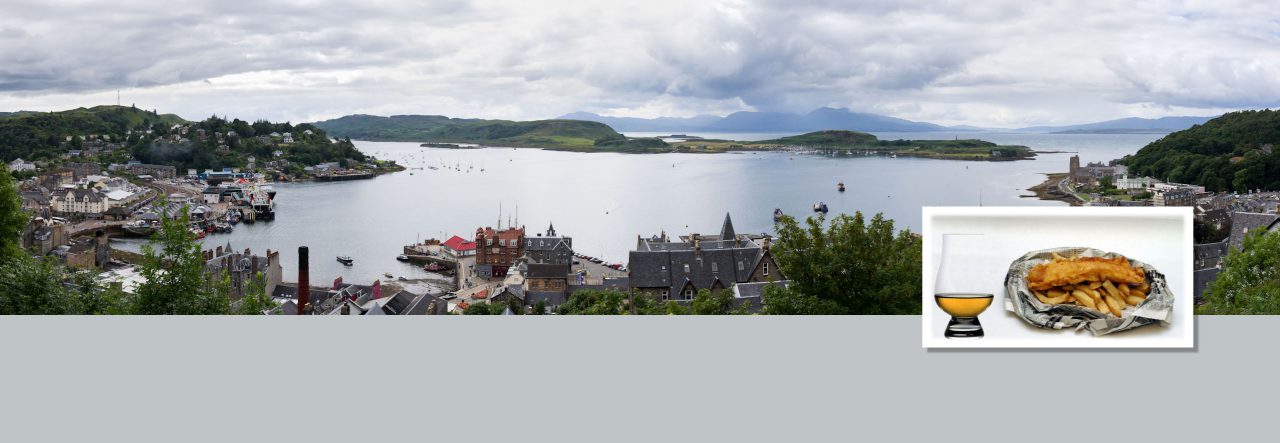In which we visit our favourite distillery on Isaly, meet our new favourite tour guide, get rather comfortable with the facility, consider moving in, decide against it, and visit an old church and a beach instead. As you do…
Another full breakfast at the Ballygrant Inn, and then ’twas time to check out. We wanted to vary things a little while on the island, so were switching to a different hotel for our last two nights. Of course, we liked the food and whisky selection at Ballygrant so much that we’re booked in for dinner and several pricey drams on Saturday. Because “too much of a good thing” is, frankly, bollocks.
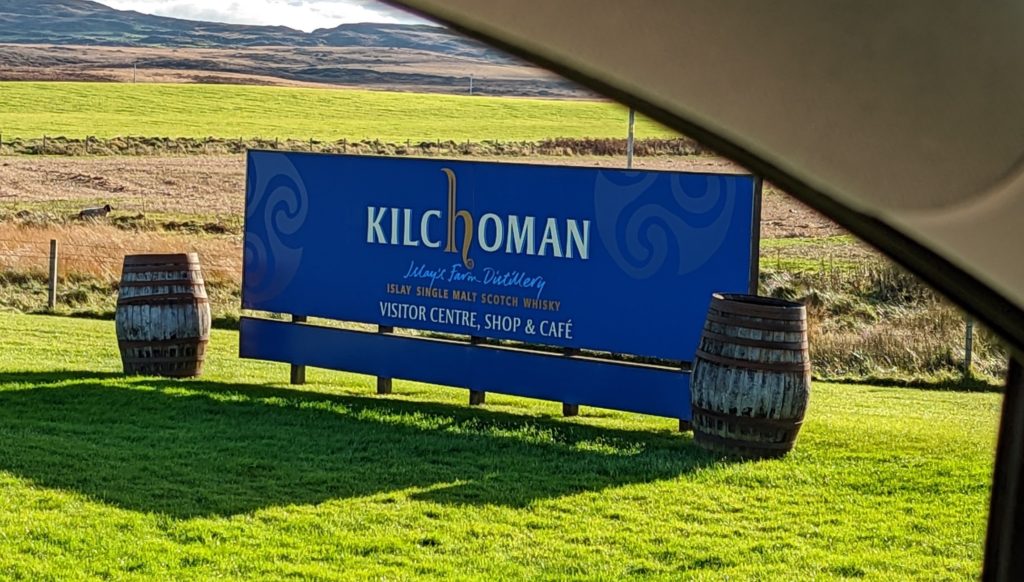
Today was the day that we were perhaps most looking forward to on Islay – the day we visit Kilchoman. My first visit to Kilchoman was back in 2016, when ’twas but a wee and new thing. The first new distillery on Islay in over a century when it opened in 2005, even by 2016 it was really just starting to make a name for itself. I’d love to say that I was so tuned in to the whisky scene that that’s why we visited… but in reality, it was the only distillery still open for tastings by the time we arrived on the island that year, so we booked it. That tasting has cost me and my fellow Whisk(e)y Soaked Souls a /lot/ of money over the years. No, you don’t understand; I mean a LOT of money over the years. Between us we have over 250 bottles (some repeats between us, with two households in particular doing the lion’s share of the collecting).
[It occurs to me that I haven’t talked in detail about the Whisk(e)y Soaked Souls yet… and I’m not gonna in this post. That’s a post unto itself, coming soon to a blog near this. The summary is that the group of nine friends that I attend whisky festivals with organized and have become if not a force to be reckoned with, then a group of whisk(e)y enthusiasts that are recognized by distillers, importers, distributers, and one liquor store manager in particular. We’re a friendly lot who love to engage anyone and everyone who’s involved with the whisky industry, so we tend to be remembered. We’re also overachievers, so we have a FB page, mailing group, business cards, a logo, and clothing. Like I said…]

Today’s visit and tour had been booked for us by James Wills, son of the owner and founder of Kilchoman Anthony Wills, and was “on the house,” which was wonderful of them. Both John and I had taken the basic tour before, but this was the “Limited Edition Tasting and Tour” tour, so something a little more in depth with some special drams at the end.
Our tour guide was Emma, and she was absolutely wonderful. Superb. Truly amazing. She spoke at my speed (read: fast; faster than most people can be bothered to listen), and I don’t think that I’ve ever heard so much detail packed in to a distillery tour (at least one that didn’t take twice as long). For example – and this hit my (barely) inner whisky geek buttons exactly right – she talked in depth about what happens inside the stills, and how the different parts of the still affect the type of spirit that’s captured for the end product vs the aspects that are intentionally left behind. No question stumped her, and she really seemed to /get/ Anthony Wills intentions for the distillery. Her knowledge of the releases was also quite impressive. Not all tour guides have that keen an insight into their distillery: for some, it’s part-time or seasonal work, so you don’t necessarily expect them to invest as much; for others, they know what they need to to do their job well, but it’s just a job after all. The best tour guides (IMH)are passionate about the industry, and/or their distillery and product in particular. Emma really knew Kilchoman and I would go so far as to say it’s worth requesting tours with her if that’s ever an option.
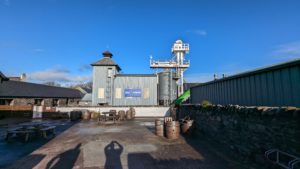
Kichoman is a farm distillery, and the only distillery left in Scotland that does everything on site: from growing barley to bottling and shipping the whisky. They started small, sharing Rockside Farm with the family that farmed it, until purchasing it from them (when they retired) in 2015. They’ve expanded twice since then but have done an amazing job of retaining their small, farm distillery feel.
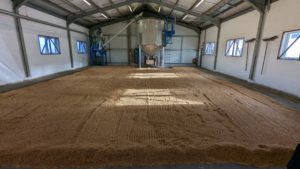
The tour followed the process in order, as most tours do, so we started at the Malting Floor. There are only 7 distilleries left in Scotland that have their own traditional malting floor – three of which are on Islay. Kilchoman has about 200 acres of barley fields, and their yield this year was about 300 tons. That’s not very much by some standards, but the growning season is harsher and a wee bit shorter than, for example, the mainland. In a good year, they’ll get about 2 tons per acre, but this year, it was just about 1-1.5 tons per. They malt up to 4 tons of barley per week, as that’s about what fits on their malting floor, and sounds like is about all that’s manageable at current scale. The barley is fed in through an aspirator that knocks out loose husks and rocks, then deposits it in a container to which water is added, and the barley steeps for 2 days. It is then dumped onto the floor and spread out to an even depth (which varies according to season / temperatures) and maintained for several days. It takes constant attention to ensure that the barley is germinating evenly, and at the correct rate. It’s checked every 3-4 hours, day and night, and is turned as needed. How and when it’s turned varies according to things like moisture, temperature, local humidity, etc. In short, it’s a lot of work that needs to be done right. This is, after all, the primary of primary ingredients. Get this wrong, and you’ve lost an entire run before it even begins.
Once the germination has reached the correct point – when the starches have converted to sugars – it has to be stopped in its tracks. This is done by heating it, and so the malted barley is shoveled over to a conveyer belt which deposits it in the kiln. The kiln is fired by peat that’s cut by hand by Derek on the Kilchoman farm. We all owe Derek a huge debt of gratitude.This Derek in particular, but we should probably thank all Dereks just to be sure. Drier peat is used to get things going, then wet peat (literally soaking in tubs outside the kiln room) is added to get the smoke on. The smoke is what infuses the barley, and does so over a period of 10 hours. After that, the fire is put out, and the barley is dried by a fan for 20-30 hours. Once we have our peat smoked malted barley, it’s taken to the stillhouse where it takes three long, scalding hot baths. But before we get to that…
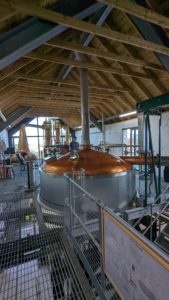
Let’s talk about the stillhouse. As I mentioned, Kilchoman has expanded in recent years, and they now have two of everything in the stillhouse: two mash tuns, two wash stills, two sprit stills. They added the new part of the stillhouse onto the old one, and mirrored it precisely. The two halves run independently, which is handy for keeping certain products separate. Most of Kilchoman’s barley is smoked to 50ppm, but not all of it. Their 100% Islay expression only calls for 20ppm. Now, the oils that come from peat smoking are a scunner to remove from the inside of the stills; it’s a practical impossibity to remove iall of it, even with deep cleaning. This means that some of this residual peat stuff is imparted into the next run. If you’ve run a dozen batches at 50ppm and want to run a batch at 20ppm, that residual oil can mess things up. Yup, even the slightest difference… But now that they have two halves, they can control that a little better and keep differently spec’d runs separate. It’s a very neat and tidy little layout.
OK, where was I. Ah yes, bath time. The barley is added to the Mash Tun, where it is soaked in water three times. This soaking extracts the sugars and flavours form the barley, and this “bathwater”, which is actually called “wort” is what goes on to be distilled. The first soaking is at about 60C and will go on to be distilled. The second soaking is at about 80C and will go on to be distilled. The third soaking extracts what little sugar is left, and is captured to be used in the first soaking of the next run. The wort is pumped in to one of the 14 stainless steel washbacks, where yeast will be added and allowed to do its thing, We weren’t allowed in to see the washbacks because, following the expansion, they’re so crammed in to the space that there’s an unhealthy amount of CO2 build-up. I’m sure it’s safe for the distillery staff, but not wise to let the general public risk it. We were told, however, that the 6,000l of wort ferments for about 60hrs before the yeast has gorged itself to death. It then sits for a further 30hrs to extract final flavors from the corpses… OK, should probably phrase that differently. This actually allows bacteria to form that give the final product some sweeter character, so it’s an important time.
Emma made a particularly insightful comment about this. Kilchoman are a young distillery, and they intentionally release young whiskies. Please note that greater age, while not irrelevant, does not in any way guarantee a good whisky. Marketing has convinced the world that whisky has to be old to be good, but that’s crap. Old can be good, and it can be bad. Young can be good, and it can be bad. Kilchoman was built to develop amazing young whiskies and it succeeds. A side effect of this is that they cannot rely as heavily on lengthy cask maturation to impart as high a degree of the character and flavor on their whisky as some of the older and larger distilleries. So there’s more work up front. This 30hrs and the subsequent bacteria development is part of that work. Brillaint, really.
OK, to the stills. Kilchoman’s stills are heated by steam coils on the inside, quite a common heating technique these days. We got to see the wash being added and brought to boil in the wash still before they closed it up, which was kindof neat. The wash still is onion shaped, fat neck, and down angle on the lyne arm. Pretty typical way to grab as much as you can from the first distillation.
Emma mentioned that the distillate came out at about 19%, which is below the 25% that I normally hear. But she clarified something that must be true everywhere and I’d just never put it together. The first distillate is joined in the “low wines” tank by the heads and tails of the second distillate, which will have a much higher percentage of alcohol. The /average/ of what sits in the low wines tank is therefore about 25%. This is the kind of little detail that I love.
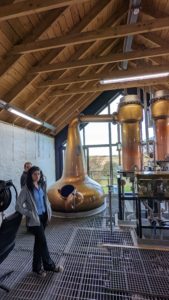
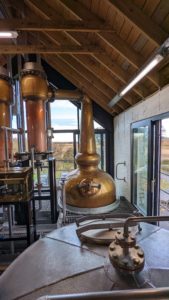
The spirit still is a very different shape: more evenly cylindrical pot, curved shoulders, a reflux ball, thinner neck, but still a slight down angle on the lyne arm. All of this is designed to remove as much of the heavier characteristics and oils as possible, while retaining the lighter, fruitier notes. That down angle on the lyne arm, however, means that some of the luckier heavier notes – the ones that make it to the top of the still – also make it into the final product. This is what gives that little richness and thickness to Kilchoman’s otherwise light and fruity sweet notes. It’s a /very/ intentional design, contributing to that up-front work I mentioned earlier.
The spirit still runs the heads for about 5 mins, until the distillate reaches 76%. The heart runs for about 90 minutes, from 76-65.5%. This is a slightly earlier cut than most/some distilleries, which will run down to 63%. Again, this eliminates some of the heavier notes that made it into the liquid.
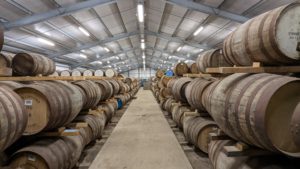
And after the distillation is done, it’s all down to the casks. Kilchoman has 6 warehouses on site, and 2 in nearby Conisby (it’s a matter of space). They source their bourbon casks from Buffalo Trace, and their sherry from Miguel Martin. There are all sorts of other casks in use, as Anthony Wills loves to experiment. We’re talking port, all varieties of red wine, all the sherries, rum, tequila, mezcal, calvados, you name it, he’s likely to have tried it. Or be trying it. Perhaps before it’s technically allowed.
Emma noted that she doesn’t think that Kilchoman will ever age stock past about the 15 year mark, at least not in any significant volume. Partly because, as mentioned before, they designed their product to be young, and that’s where its characteristics shine. And partly because, perhaps as a result of this intentionality, a lot of the core characteristics disappear at these older ages. In fact, this is almost certainly the case as heavier notes last longer in the casks, though not forever. As Iain MacArthur noted during out Lagavulin tasting, oak really tempers peat smoke in a whisky, and by the time you hit mid-to-late teens, it has become a very mild part of the whisky’s character. Emma believed that too much of what makes Kilchoman Kilchoman would be lost with longer maturations, so doesn’t see it being a goal of the distillery.
There’s also a bit of a movement in the industry towards younger (often No Age Statement or NAS) whiskies. The various distillery closures of the 80’s and early 90’s are starting to show in the stock levels: there ain’t enough. Hardly surprising for a product that wants 10-20 years of aging but the producer had to shut down for 15 years. The older stock just isn’t there (yet). Distilleries like Kilchoman are able to shine, and perhaps even lead the way, demonstrating that you can still release a great product while waiting for your more familiar product to age appropriately. Think Ardbeg Wee Beastie, which is but a nipper at 5 years old, as a great example.
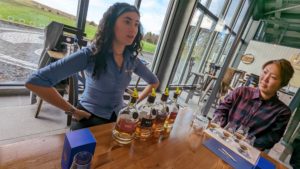
Like I said, a phenomenally detailed tour (I missed out a lot – it you want the rest, visit Kilchoman and ask for Emma). Once we were done, it was back to the tasting room where we tasted and talked and entirely failed to stump Emma. Honestly, I could’ve listened to her talk for hours. Actually, I suppose that I did. Heh. We gave her a hearty round of applause and she left us to finish our drams.
- 100% Islay 12th Edition, 50%
- Casado (Portuguese Wine Vat Matured), 46%
- Loch Gorm 2022, 46%
- Madeira Cask Matured, 50%
- Distillery Exclusive Calvados Double Cask Finish, 50.?%
The Casado was outstanding, almost a subtle take on the STR finishes. Dr Swann would be proud. When it hits the US, I’ll be one of the first in line (likely with other members of the Souls). The Calvados is everything I wanted in a previous attempted Calvados finish that didn’t work too well: bright and baked apples eeking through the smoke and peat. A distillery exclusive… so we’ll be walking out with one of those.

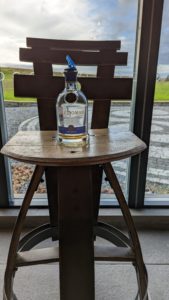
After the tour was done, we hit the tasting bar because of course we did. There were a few unique or older drams we were interested in that we just ain’t gonna find anywhere else ever again. They were even out of a couple we were interested in (I’m going to have to wait a while for the next rum cask, I suppose).
- Machir Bay Cask Strength European Tour 2014 Ed., 59.2%
- Distillery Exclusive Marsala Cask Finish, 50ppm, 52.5%
- Comriach Batch 5 (Port Matured), 55.5%
After loitering at the bar for a while, chatting with Sharon (who turns out to be Emma’s mum), we took a wee break and grabbed lunch. As the driver, there are some distillery visits where I’ll be asking for the driver’s dram – bottled samples from the tour that I can drink in the safety of the hotel room /after/ I’ve driven us there. Kilchoman was not one of those distilleries. Are you effing kidding me? No chance! But I’m not one to down a half-dozen drams then jump in a car because “I feel fiiiine…”. That’s just stupid. No, when I drink at the distillery, I wait the required amount of time before getting behind the wheel. Lunch was the perfect way to take a break, slow the alcohol’s entry to my blood stream, and give us the excuse we needed to hang around a wee bit longer at this wonderful place.
After lunch, we bought some stuff: the distillery exclusive bottling that I told you I’d buy, and a few driver’s drams to take home for the ladies. Just wee 25ml pours of some of the rare stuff that I think they’ll enjoy.
Then we snagged a picture with Emma and finally left. Before they threw us out. Seriously, we were there longer than some of the staff.
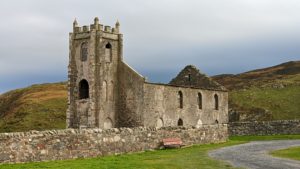
Before heading to the new hotel, John wanted to visit Kilchoman church, which he’d missed on his last visit to the area, and we both wanted to pop down to Machir Bay, which the distillery’s flagship expression is named after. The church is a ruin, but one of those ruins that exudes what it once was. You can’t actually get into it because “ruin” is very appropriate and still in process, but walking around the outside is still a thing (especially as the cloudier weather rolls in behind it… talk about atmospheric). There’s a small military cemetary next to it that is still actively visited, which adds to the almost somber sense of the area.
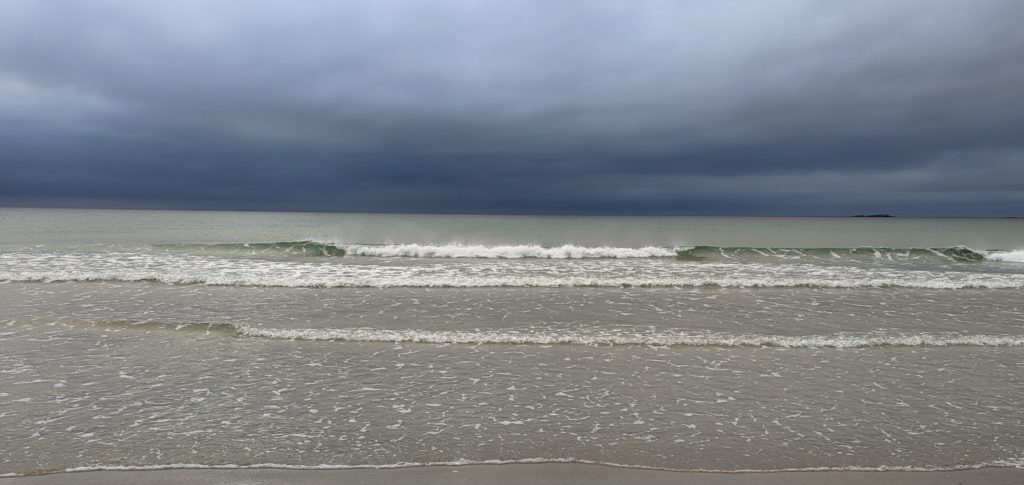
Machir Bay, just along the road, is a stunning sandy beach with an incredibly calming view of the North Atlantic. Again, the clouds sweeping in gave it a particularly dramatic feel, and we just sort of stood and drank it in for a while. Eventually, we wandered back to the car and headed to the new hotel.
New hotel is the Bridgend Hotel, which I’d always thought was a tiny wee place, and pretty average, based on the drive-bys I’d done in the past. Wrong on both counts. Larger than it looks (though not large by any means), the accommodations are immactulate and charming, the dining room and food quite splendid, and the bar area very casual. Not nearly the selection of whiskies that the Ballygrant boasted, but then that would be tough. Still, I managed to add another couple of Octomores to my list, which makes me happy.
Tomorrow will bring one booked tour, perhaps some artwork, and a do-it-yourself visit, just to ensure we hit all functioning distilleries on the island before we leave. But that’s tomorrow. For today, we’re done.
